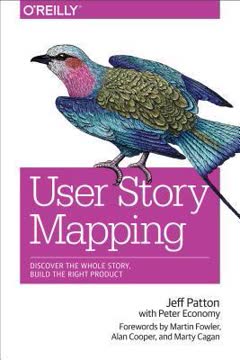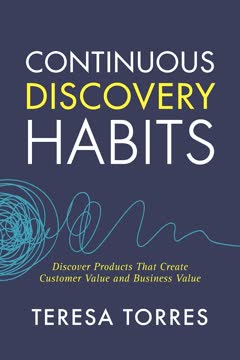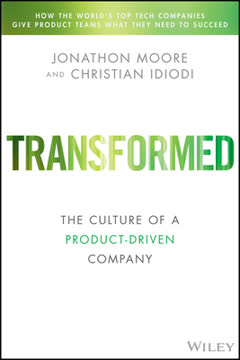Key Takeaways
1. Transform to the Product Model for Consistent Innovation
The product operating model is about consistently creating technology-powered solutions that your customers love, yet work for your business.
Competitive advantage. In today's rapidly evolving business landscape, companies must transform to the product model to remain competitive. This model enables organizations to consistently innovate and respond effectively to market changes and customer needs.
Key components. The product model involves three critical dimensions:
- Changing how you build: Moving from infrequent, large releases to continuous delivery
- Changing how you solve problems: Empowering cross-functional teams to discover effective solutions
- Changing how you decide which problems to solve: Developing strong product leadership and strategy
Cultural shift. Transforming to the product model requires a significant cultural change, moving away from top-down, command-and-control structures to a more collaborative, empowered approach. This shift enables companies to leverage the full potential of their technology and talent to create innovative solutions that truly meet customer needs.
2. Empower Cross-Functional Product Teams to Solve Customer Problems
Innovation absolutely depends on empowered engineers.
Team composition. Empowered product teams consist of product managers, product designers, and engineers working collaboratively to solve customer problems. Each role brings unique expertise:
- Product managers: Responsible for value and viability
- Product designers: Responsible for usability
- Engineers: Responsible for feasibility
Direct access. Teams must have unencumbered access to:
- Users and customers
- Product data
- Business stakeholders
Collaborative problem-solving. By bringing together diverse perspectives and skills, empowered teams can discover innovative solutions that meet customer needs while aligning with business objectives. This approach leverages the technical knowledge of engineers, the customer insights of product managers, and the user-centric focus of designers to create truly effective products.
3. Change How You Build: Implement Continuous Delivery
Shipping lots of features may make you feel good, but unless that translates into real business results, you fail.
Frequent, small releases. Move from large, infrequent releases to continuous delivery of small, incremental changes. This approach:
- Reduces risk
- Improves product quality
- Enables faster response to customer needs
Key practices:
- Implement automated testing and deployment
- Instrument products for data collection and monitoring
- Develop robust deployment infrastructure for controlled releases
Benefits. Continuous delivery allows companies to quickly iterate on products, gather real-time feedback, and make data-driven decisions. This agility is crucial for staying competitive in fast-moving markets and meeting evolving customer expectations.
4. Adopt Product Discovery to Find Solutions Worth Building
Everything you build and deploy needs to be instrumented such that you know how your products actually are being used. Without this data, you are flying blind.
Risk assessment. Product discovery focuses on addressing four key risks before building:
- Value risk: Will customers buy or use it?
- Usability risk: Can users easily learn and use it?
- Feasibility risk: Can we build it with our current resources?
- Viability risk: Does it work for our business?
Rapid experimentation. Embrace techniques for quickly testing ideas:
- Prototyping
- User interviews
- A/B testing
- Data analysis
Evidence-based decisions. By thoroughly exploring and validating ideas before committing resources to building, teams can significantly reduce waste and increase the likelihood of creating successful products that deliver real value to customers and the business.
5. Develop Strong Product Leadership and Strategy
The heart of the matter is the question: What is more important for this effort: hitting this date or accomplishing this outcome?
Strategic context. Product leaders are responsible for providing:
- Compelling product vision (3-10 years out)
- Insight-driven product strategy
- Effective team topology
- Clear team objectives
Coaching and development. Leaders must prioritize coaching their teams, spending significant time developing the skills of product managers, designers, and engineers.
Outcome focus. Shift from output-based metrics to outcome-based goals, holding teams accountable for business results rather than simply shipping features. This approach encourages innovation and ensures that product efforts align with overall business objectives.
6. Establish New Product Model Competencies
To be explicit on this critical point, if the tech lead is unable or unwilling to engage in product discovery, then you are very likely guaranteeing that the eventual product will not achieve your goals.
Key roles:
- Product managers: Deep understanding of customers, data, and business
- Product designers: Skilled in interaction design and prototyping
- Tech leads: Engaged in both discovery and delivery
Skill development. Invest in developing these competencies through:
- Targeted hiring
- Ongoing coaching and training
- Clear job definitions and expectations
Collaboration. Foster a culture of collaboration among these roles, encouraging shared ownership of product outcomes and leveraging diverse perspectives to drive innovation.
7. Transform Organization Culture to Support Innovation
100% predictability = 0% innovation.
Key principles:
- Principles over process
- Trust over control
- Innovation over predictability
- Learning over failure
Experimentation mindset. Encourage teams to take calculated risks and learn from both successes and failures. Create an environment where it's safe to experiment and iterate rapidly.
Continuous improvement. Foster a culture of ongoing learning and adaptation, regularly reflecting on processes and outcomes to identify areas for improvement.
8. Partner Effectively with Stakeholders and Executives
Product teams depend on executives to provide as many degrees of freedom as possible to solve the problems they're assigned.
Collaborative relationships. Build strong partnerships with:
- Sales
- Marketing
- Finance
- Customer success
- Executives
Clear communication. Regularly share product vision, strategy, and outcomes with stakeholders to build trust and alignment.
Balancing needs. Work to find solutions that meet both customer needs and business constraints, involving stakeholders early in the discovery process to address potential issues.
9. Address Common Objections to Transformation
If you're working on changing how you solve problems, this begs the question: Where are the problems coming from?
Common concerns:
- Loss of control for stakeholders
- Perceived lack of predictability
- Resistance to changing roles and responsibilities
- Fear of job security
Addressing objections:
- Clearly communicate the benefits of the product model
- Provide examples of successful transformations
- Offer training and support for new roles
- Demonstrate early wins to build confidence
Continuous evangelism. Regularly reinforce the principles and benefits of the product model throughout the organization to maintain momentum and support for the transformation.
10. Measure Success by Business Impact and Customer Value
If a product team doesn't produce real results for your customers and your company, then what have you really accomplished?
Outcome-based metrics. Focus on:
- Customer adoption and satisfaction
- Revenue growth
- Cost reduction
- Market share gains
Continuous improvement. Regularly assess and iterate on products based on real-world data and customer feedback.
Long-term perspective. Recognize that transformation is an ongoing process, with success measured over time through sustained innovation and business growth. Celebrate both quick wins and long-term achievements to maintain momentum and motivation throughout the organization.
Last updated:
FAQ
What's Transformed: Moving to the Product Operating Model about?
- Focus on Transformation: The book explores how organizations can shift to a product operating model, requiring a cultural change in product development and delivery.
- Empowered Teams: It emphasizes the role of cross-functional, empowered product teams in solving customer problems rather than just delivering stakeholder-driven features.
- Case Studies: Real-world examples from various companies illustrate successful transformations and the principles that contributed to their success.
Why should I read Transformed: Moving to the Product Operating Model?
- Practical Guidance: Offers actionable insights and techniques for leaders aiming to implement a product operating model.
- Addressing Challenges: Tackles common objections and challenges during transformation, providing strategies to overcome them.
- Expert Authors: Written by industry experts Marty Cagan and his team, drawing on decades of experience in product management.
What are the key takeaways of Transformed: Moving to the Product Operating Model?
- CEO's Role: Highlights the critical role of the CEO in driving transformation and supporting product teams.
- Outcome Focus: Advocates for a shift from output (features) to outcomes (customer satisfaction and business impact).
- Continuous Learning: Stresses the need for a culture of experimentation and learning, allowing quick iteration based on feedback.
What is the Product Operating Model defined in Transformed: Moving to the Product Operating Model?
- Conceptual Framework: Described as a model based on first principles, focusing on customer-centric solutions.
- Empowerment and Collaboration: Emphasizes empowering teams to solve problems collaboratively, moving away from top-down feature dictation.
- Adaptability: Encourages organizations to adapt practices based on their unique contexts and challenges.
How does Transformed: Moving to the Product Operating Model suggest companies should change how they build products?
- Frequent Releases: Advocates for small, frequent, and reliable releases to iterate quickly based on user feedback.
- Continuous Delivery: Emphasizes CI/CD practices to enhance product quality and responsiveness to market needs.
- Focus on Learning: Encourages minimizing waste by learning from experiments and testing ideas before full-scale development.
What are the roles of product managers, designers, and tech leads in the Product Operating Model?
- Product Managers: Responsible for understanding customer needs and ensuring solutions are valuable and viable.
- Product Designers: Focus on usability and user experience, ensuring products meet customer expectations.
- Tech Leads: Oversee solution feasibility, aligning technical aspects with product team goals.
What is the significance of product discovery in Transformed: Moving to the Product Operating Model?
- Understanding Needs: Crucial for identifying the right problems to solve and aligning solutions with customer needs.
- Rapid Experimentation: Encourages rapid experimentation to test ideas quickly and efficiently.
- Iterative Process: Highlights product discovery as an ongoing process for adapting and refining solutions based on feedback.
How does Transformed: Moving to the Product Operating Model address objections from stakeholders during transformation?
- Identifying Concerns: Outlines common objections from stakeholders and provides strategies to address them.
- Building Trust: Emphasizes transparency and communication to build trust and ensure alignment on goals.
- Engagement and Collaboration: Advocates involving stakeholders in the product discovery process to foster collaboration.
What are some of the innovation stories shared in Transformed: Moving to the Product Operating Model?
- Almosafer: Adapted to the pandemic by leveraging its product model to meet new customer needs.
- CarMax: Transformed operations to enhance its omnichannel experience during the pandemic.
- Trainline: Shifted from a legacy model to a tech-powered product organization, improving market position.
What are the principles of a strong product culture as described in Transformed: Moving to the Product Operating Model?
- Principles Over Process: Prioritizes principles fostering innovation and responsiveness over rigid processes.
- Trust Over Control: Advocates for a culture of trust, empowering teams to make decisions and take ownership.
- Learning Over Failure: Encourages viewing failures as learning opportunities, promoting continuous improvement.
What are the best quotes from Transformed: Moving to the Product Operating Model and what do they mean?
- "Shipping features won't necessarily solve the underlying problem for the customer or the business.": Emphasizes solving real customer problems to create value.
- "Empowerment depends on a degree of trust.": Highlights the necessity of trust for effective collaboration and decision-making.
- "The promise is not to build—and certainly not to ship—any solution that does not meet the critical needs of the business.": Stresses alignment of product work with business objectives and customer needs.
How can organizations measure the success of their transformation to the product operating model?
- Key Performance Indicators (KPIs): Establish clear KPIs aligned with business outcomes to track effectiveness.
- Customer Satisfaction Metrics: Measure customer satisfaction and engagement to assess product alignment with user needs.
- Continuous Improvement: Adopt a mindset of continuous improvement, regularly reviewing processes and outcomes for enhancement.
Review Summary
Transformed receives mixed reviews, with ratings ranging from 2 to 5 stars. Many readers find it repetitive of Cagan's previous works, particularly for those familiar with "Inspired" and "Empowered." Some appreciate its focus on organizational transformation and product operating models, while others criticize its lack of depth and practical advice. The book is seen as more valuable for executives and newcomers to product management, offering case studies and principles for transforming companies. However, some readers feel it lacks originality and serves more as a sales pitch for consulting services.
Similar Books










Download PDF
Download EPUB
.epub digital book format is ideal for reading ebooks on phones, tablets, and e-readers.






